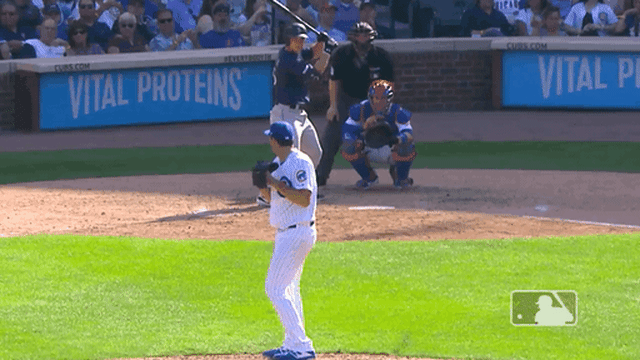
Between Wieck and Wick, Cubs Burning Curveball Candle at Both Ends
Most Cubs fans had no idea what Brad Wieck was capable of, so you can’t blame Kyle Seager for being a little confused in the box Monday afternoon. Even the most educated portions of the fanbase, maybe even throughout the professional ranks of the game, knew little about the 6-foot-9 southpaw beyond his stature and a decent fastball/breaking ball combo. Wieck had missed his share of bats in the Padres organization, but he’d also found far too many barrels.
So what did the Cubs do upon acquiring the lefty in exchange for Carl Edwards Jr. at the trade deadline? Why, they paired him up with pitching analyst Josh Zeid and put him to work in their vaunted Pitch Lab. The result was a tweak to his breaking ball grip that has him throwing one of those spike curveballs that have become all the rage recently.
“As soon as I got traded, we started messing with my off-speed (pitches)” Wieck told the Tribune’s Mark Gonzales. “That’s where I was lacking. My fastball plays, but my off-speed wasn’t at the time. So we got to work and messed around with some grips and figured out some stuff.”
It was evident just from scouting the box score that Wieck would need to make some changes to his breaking stuff, which was being tagged for homers. Some of that may have been a matter of confidence and experience, both of which are subject to the whole change-of-scenery bump we so often hear about.
As much as that may be viewed as a lazy trope, there are plenty of legitimate factors underpinning what could otherwise be seen as a product of chance. While it’s possible that a trade wakes a player up psychologically or gives him reason to succeed just to spite his old club, it’s more likely that small changes to mechanics or repertoire unlock latent potential.
There’s also the matter of getting a fresh set of eyes looking at something or a new voice sharing advice. The willingness to listen and maybe to get outside of one’s comfort zone, can be huge when it comes to taking that next step.
“We got in the lab, started spinning some stuff and got dialed in,” Wieck explained. “It’s good. I like they’re forcing me to throw it more. I’ve been a fastball-heavy pitcher my whole life. I trust my fastball with my life. To have a catcher there and make you throw (the curve), that’s really good.”
If this sounds like something you’ve heard before, it’s because you probably have. And with a pitcher who’s last name sounds exactly the same, to boot. Rowan Wick has only been pitching for about three years and did so as a way to cling to his professional baseball career. But after putting in a little work of his own in the lab, he’s become a go-to option for the Cubs at the back end of the ‘pen.
“It was like, ‘Yeah, this is the one that has the best spin and the best efficiency and all that,’” Wick explained to MLB.com’s Jordan Bastian of his switch to a spike curve. “It was a good velo, so I stuck with that. Really, you just throw it like a fastball, you know what I mean?
“You don’t have to think about making it break or anything. The grip just does it for you.”
Despite the similarities in their names and their newfound ability to spin wi(e)cked curveballs to offset mid-90’s heat, no one is going to mistake Wick for Wieck on the mound. One looks like the converted catcher that he is, firing pitches directly out of his right shoulder with a compact arm stroke, while the other towers on the mound and releases the ball from a lefty batter’s head.

That’s what Seager was thinking, anyway, which is why he turtled up to avoid getting plunked. Since his head was firmly ensconced it his shell, he had no idea that the pitch had bisected the plate and looked bewildered when the umpire rang him up. Wick went on to get Ryan Court swinging to end the game, giving him three strikeouts of four batters faced with the Cubs.
Now, he could give up homers to the next four batters he faces and we’ll all forget about how he embarrassed Seager, but this doesn’t look like a small-sample aberration. In both Wieck and Wick, the Cubs saw something they could work with and made small tweaks to maximize their respective profiles. It’s almost like coming upon an unfinished sculpture and breaking out a chisel to reveal a few necessary details.
And that’s a little weird, right? An organization that has publicly admitted its inability to properly draft and develop pitchers can somehow take rough gems from other teams and polish them into legit bullpen options. Maybe they just need to make all their prospects throw the spike curve or something. Okay, it’s not that easy.
Learning a new pitch is one thing, executing it properly is another. After all, not everyone can be Yu Darvish, who integrated the pitch into his famously broad mix within a few days of learning it from Craig Kimbrel. But there is perhaps something the Cubs can learn from the profiles of the pitchers they’ve reclaimed, so to speak. Or maybe they already have, since they’ve talked about a shift away from “safe” pitchers and toward those with a little more risk.
It’ll take a while for that philosophy to yield fruit, though, so for now the Cubs are just going to have to keep burning the candle from both ends with Wieck and Wick.

